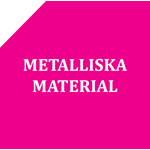Projektinitiativ #7: Medium-to-high entropy iron/chromium-based alloys ( 4 kommentarer)
According to thermodynamics rules, increasing the entropy of mixing in alloys and thus minimizing the total free Gibbs energy of an alloy is the key to stabilize the microstructure, hence the overall mechanical/physical/chemical properties at cryogenic/elevated temperatures. This concept has been used in defining new advanced type of alloys, named as high entropy alloys (HEAs).
Ehsan Ghassemali presents the initiative during the 2017 conference
By definition, HEAs, that are also called multi-component alloys, contain five or more principal alloying elements in equiatomic or near equiatomic proportions. Such an alloy design could lead to outstanding and unique mechanical, physical and chemical properties at harsh conditions such as cryogenic and high temperature applications. Nevertheless, due to equiatomic proportionality of pure alloying elements, high production cost has been somewhat an obstacle for industrialization of these alloys, which has limited their applications. In addition, it is rather difficult to produce these types of alloys within their range of compositions. This has limited the choices of production method to mostly powder metallurgy and coating techniques. Production of bulk HEAs with advanced properties by different processes seems to be more competitive at industrial scales.
As a continuous discussion with related industries, the aim of this project is to improve the HEA design concept for developing and adjusting existing traditional iron/chromium-based alloys into complex, yet non-equiatomically proportioned (cost efficient) medium-to-high entropy alloys.
The main design criteria would be microstructural or mechanical stability and oxidation resistant at high temperatures, as well as improved formability at room and/or elevated temperatures. Relative reduction in density of the alloy would be also a consequence of such a design.
Namn Ehsan Ghassemali
Organisation Jönköping University, School of Engineering, Dep. Materials and Manufacturing
Kommentar #1
Interesting initiative. The objective could be more focused, to get started: which system to start with, with which particular target in mind, and how is that target justified.
It would be good to see some relevant industries are involved in this initiative, providing some perspectives from the end users.
Namn Sheng Guo
Organisation Chalmers University of Technology
Kommentar #2
Adjusting the heat resistant of the alloy is interesting as well as abrasive resistant at higher temperatures. This can be done by adding W to the alloy. However this is an expensive element and it has a high density. Instead it would be interesting to see what Nb could do to improve the properties outlined in this idea.
Namn Sten Farre
Organisation Programkontoret Metalliska Material
Kommentar #3
The cost/weight/property trade factors will be different for different application/market segments. Is there a view on what the project wants to achieve or will the project more evaluate a new composition regime to see where the property falls out?
Methods:
- Will the project mainly look at new compositions experimentally?
- How will mechanical, thermal and chemical stability properties be evaluated?
- How will manufacturing processability be evaluated?
- This seems to be a study on TRL2-level where the technology is trying to find an application.
Namn Anders Sjunnesson
Organisation GKN Aerospace Engine Systems
Kommentar #4
I agree with previous comments that it is a low TRL project. However, the iron chromium "corner" of the HEA alloys is very interesting and I think that more basic knowledge of these alloy systems is interesting. Perhaps it is necessary to focus on either "hard" alloys or corrosion resistant alloys and not both.
Namn Sven Bengtsson
Organisation Höganäs AB

